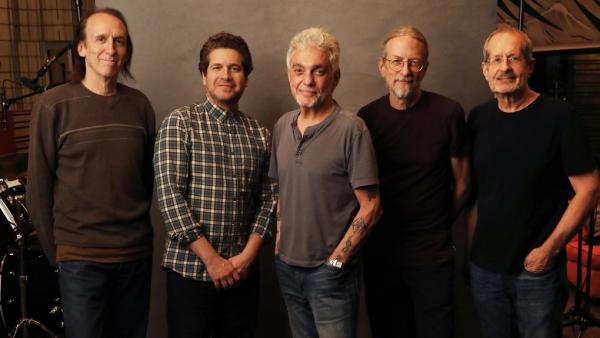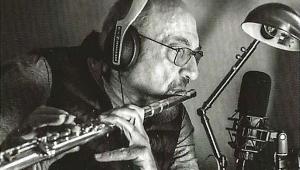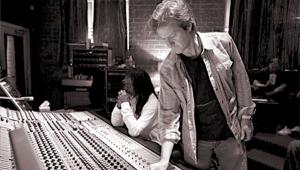Drummer’s Drummer Steve Gadd Is the Consummate Team Player

There are drummers who are master timekeepers, drummers who are lords of the backbeat, drummers who seek to impress with dazzling displays of their endless chops, and drummers who are simply larger than life. And then there’s Steve Gadd, the true drummer’s drummer who’s also quite well-respected by the audiophile community.
Gadd’s work behind the kit over the years with the likes of Eric Clapton, James Taylor, Steely Dan, and Paul Simon has set a template for how to best serve songs and the artists who create them with style, grace, and class. Gadd also finds the time to spread his wings as both a bandleader and producer, as he’s done with the tasteful jazz that permeates the 11 master-class tracks on the recently released self-titled salvo, Steve Gadd Band (BFM Jazz).
Despite all the renown and continual accolades, Gadd remains, at heart, a team player through and through. When I asked him about the iconic drum pattern he created for the intro to and ultimate bedrock of Paul Simon’s enduring No. 1 1975 hit “50 Ways to Leave Your Lover,” Gadd demurred to the studio expertise of producer Phil Ramone and his fellow players. “It’s always kind of a group thing,” explains Gadd (at center in the above band photo). “You’re looking at the producer and the artist for input, watching their reactions, and listening to what they say. We all put our heads together and came up with that one. But Phil Ramone — he was just a master.”
You’re a master too, Steve. Before the SGB headed across the Pond for a European tour, Gadd, 72, and I got on the line to discuss how to capture dynamics in the studio, how you can best identify which vinyl albums are really your favorites, and, of course, his indelible, incendiary solo section on the title track to Steely Dan’s 1977 masterpiece, Aja.
 Mike Mettler: My understanding is you recorded Steve Gadd Band in a North Hollywood studio named Sphere Sound, a studio you guys had never been in before. Does it take a while to get used to recording in a new space, and figuring out how it sounds in there?
Mike Mettler: My understanding is you recorded Steve Gadd Band in a North Hollywood studio named Sphere Sound, a studio you guys had never been in before. Does it take a while to get used to recording in a new space, and figuring out how it sounds in there?
Steve Gadd: Yeah, and that happens all the time. It takes a minute to get used to the room you’re playing in, the ’phones [i.e., the cans/headphones], and all that stuff. But we did pretty good. We worked on the arrangements a little bit before we got into the studio, and when we got in there, we had to tweak them a little bit. But, yeah, it’s a fun process.
Mettler: Pretty much everybody in the Steve Gadd Band has worked with producer/engineer Dave O’Donnell on some of James Taylor’s recent studio recordings, like 2015’s Before This World. Did you consult with Dave in terms of any of the engineering or production choices you made here?
Gadd: No, no. We just put our heads together, and we came up with a guy who we all liked, Rich Breen [listed in the SGB credits as “tracking and mixing engineer”]. Some of the guys knew Rich before, but I had just met him. And it worked out just fine.
[Over his career, Breen has garnered a number of Grammy nominations and a few Grammy wins for his work with the likes of Al Jarreau, Yellowjackets, Billy Childs, and Charlie Haden.]
Mettler: Right off the bat with the opening track, “I Know, But Tell Me Again,” I feel like I could visualize the interplay that’s going on between all of you, and the way you guys play off of each other as the song unfolds.
Gadd: While the trumpet [Walt Fowler] and the keyboard [Kevin Hays] were in other rooms, we could all see each other when we were playing at the same time. To me, what I like about this album is that it’s dynamic. A lot of times, the dynamics go right out the window. Everything is mixed loud and in your face, you know what I mean?
Mettler: I do. I hear some different volume dynamics throughout the record, where in some places it’s pushed forward more than others. Are you, as the producer, the one making those choices as to where to dial it up in the mix — or back, like in “Skulk,” for example?
Gadd: Yeah. One of the first things that can get covered up when we mix is the sound of the cymbals. When that goes away, that’s one of the main ways you can tell how loud the drummer was playing, and how he was hitting the ride cymbal.
Mettler: Is the beginning of “Foameopathy” a good example of capturing that kind of cymbal character?
Gadd: Yeah, and I tried to give a feeling dynamically of how it was feeling right when we did it.
Mettler: I also love how good the cymbal work sounds on “Auckland by Numbers.” In that song especially, I think it’s critical that it sounds as good as it does there, or else the whole song would fall flat.
Gadd: I like “Auckland by Numbers” too. I thought Mike [Michael Landau, guitarist] wrote a great song. And the cymbal work there is really critical. You’re the first person who’s ever really said that back to me, but it really is. I agree with you 100 percent on that.
You’ve gotta have a great engineer when you’re recording stuff like that. It’s gotta go on tape just right. And then when you’re mixing it, you have to communicate exactly what you’re trying to do.
For me, I try to not cover up on the first overdub everything that went down on the original tracks. A lot of times, the last thing that got played is the loudest. You’ve gotta remember where the thing started dynamically, and try to keep everything else in perspective in that way. As soon as a guy starts soloing and you put it upfront, it covers up everything else. I don’t think it needs to be that loud to be heard. I like to make it feel like it’s “in” the band. You need to hear how everyone is supporting everybody else.
If I’m playing really light on the hi-hat and someone else plays the melody so loud that it covers everything up, then to me, the melody’s too loud. If I’m playing that light, we’ve gotta bring stuff back so you can hear that. Instead of turning the hi-hat up and making it sound like I was playing louder than I was, bring stuff back so you can hear dynamically where we’re all starting. Then you’ve got somewhere to go.
Mettler: True. And if Michael’s guitar was too loud in the “Auckland” mix, the whole song would be thrown off.
Gadd: Exactly. And you can still hear what Michael is doing perfectly. You can hear that in this mix, right?
Mettler: I can, yes, and that’s key to understanding the interplay of all the people playing on any given track. “One Point Five” is another track like that — though I think we have to get somewhat dyslexic and call it “Five Point One.” Since there’s a drumming circle on that song, it would be amazing to hear it go literally around the room in the speakers in a surround sound mix.
Gadd: (chuckles heartily): You definitely hear things the way I hear them. But wow, that’s a good idea. Maybe I’ll ask Dave [O’Donnell] about how to do that.
Mettler: Oh, I think you totally should ask him about that! Is vinyl still important to you as a listener?
Gadd: I love vinyl, and I always used to listen to music that way. I always liked being able to put the needle on whatever I want to play. It’s along the lines of playing an instrument where you have more control over what you want to listen to. And, of course, the sound is real-sounding. I don’t know any other way to describe it. But when I was growing up, I would start a song in the middle, and just zero in on the drum breaks.
Mettler: Did you also slow things down to hear the patterns differently?
Gadd: I did. When I was zeroing in on what the drummers were doing, I would slow it down a lot of the time.
Mettler: Would you do that with drummers like, say, Gene Krupa?
Gadd: More like with Tony [Williams]. Gene was a little easier to understand. Tony, and some of the players who were considered his followers, were a little harder to understand what they were doing, so I had to slow him and them down to check all that out.
Mettler: What albums did you do that with?
Gadd: I did it with a lot of the Tony stuff with Miles, like Seven Steps to Heaven [a 1963 Miles Davis release of mostly uptempo standards covers]. It had a lot of those quirky little Tony breaks — the ones he was the first one to ever think of like that, you know what I mean? And mostly I did it with Tony because he was so different when he came along.
Another thing I like about albums — you can tell when you take the album out of the cover how much play it’s gotten. The cover will be worn out, you know? I had to replace some of my vinyls because I played them so much.
I have a lot of them — all the Miles stuff, and a lot of Elvin [Jones] too. Even a lot of pop albums. Some of the things I’ve recorded, I’ve listened to on vinyl, and they’ve sounded great. If I go through my vinyl collection, I can tell just by how worn they are, and it just brings back memories.
Mettler: And that’s the stamp of approval, right? Well, one record I can tell you that was worn out by being played many times on my turntable is Steely Dan’s Aja (1977). Here in the audiophile community, many of us audition that one drum solo sequence of yours on the back half of the title track to see how speakers can handle material with such a dynamic nature.
Gadd: Oh, I didn’t even know that.
Mettler: It’s true. The way you and [tenor saxophonist] Wayne Shorter play off of each other there is quite dynamic, but you didn’t even play that together, right? He had listened to what you had done on a separate playback.
Gadd: I can’t exactly recall, but I think the Wayne thing came after mine. I don’t think I listened to him before I did my thing, but I can’t remember for sure. You know, I was just trying to understand musically what they [i.e., Steely Dan’s major domos, Walter Becker and Donald Fagen] wanted me to do there in terms of how “busy” it was, and I was trying to play around those figures.
What I did there was pretty much set. It was building toward the end of the song, and that’s the way I would have approached it either way. Those were the figures they wanted me to cover — so that’s what I did.
Mettler: There are a number of different movements in the song overall. The first half is more about what those guys are doing and setting up the long haul of it, and the back half is more about what you and Wayne are doing. You move it into a different direction. You’re essentially the featured players in that back half. Usually, you’re more of a support mechanism for the artists you work with, but here, you’re put in the front of it.
Gadd: That was definitely a different situation. And especially more for pop music, to get that busy, that was a different thing — but it sure worked out good for those guys!
Mettler: That is true! And “busy” is a good word for it. It’s definitely a furious section. It’s almost your coming out party, in a way. Those sixteenth-note triplets at the very end are really a Steve Gadd trademark, I think.
Gadd: I guess, yeah! (chuckles) That’s just the way it was. And it was not normal for that to happen in pop music. It was more of a jazz thing at the end, and it pulled it together. They tied it all together.
Mettler: Last thing: You named an album about entering into your 70s [70 Strong, released in April 2015]. Do you feel more energized now to play even more live dates? You’re not going to slow it down anytime soon, right?
Gadd: I love playing music, so I don’t plan on quitting, and I’m not stopping. I do enjoy it. When you get on the bandstand and are playing with some good guys, it’s energizing. That can ease a lot of the fatigue that comes with all the traveling. And playing good music with good people up on the bandstand makes you feel like you need less sleep! (both laugh)





























































